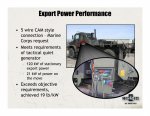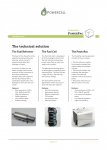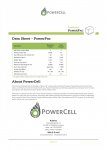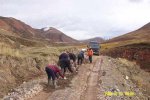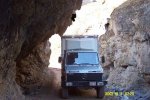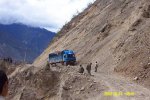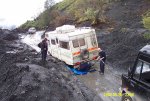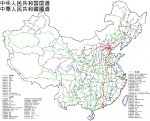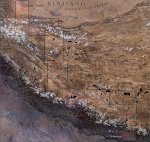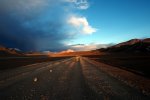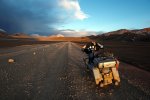biotect
Designer
.
CONTINUED FROM PREVIOUS POST
***********************************************
Next, in the typical "down" cycle it seems that for the most part the TAK-4 suspension only flattens out, and the centerline of the MTVR does not drop below the wheel centers:



There is, however, one moment in the video where the MTVR's centerline does appear to drop a bit further than the wheel centers:

But there is no question that the MTVR's wheels can travel downwards much further than they can travel upwards. Here are some images of the wheels traveling downwards to the maximum extent:



So presumably when one tire raises, TAK-4 seems to act pretty much like straight-axle suspension. The first video posted below speaks to this issue very directly, and seems to suggest that although the MTVR has TAK-4 independent suspension, its centerline still does lift when one wheel raises. It's difficult to say how much, because a mud-flap blocks the view. Also see posts #1111 and #1112 for a visual analysis of TAK-4i in Oshkosh's L-ATV, at http://www.expeditionportal.com/for...edition-RV-w-Rigid-Torsion-Free-Frame/page112 .
[video=youtube;I7m69PzF4TQ]https://www.youtube.com/watch?v=I7m69PzF4TQ&index=5&list=PLHf4lVyYcHP92n2K pHw71g7iBEjFotEFu[/video] [video=youtube;mvqI_d1ymcs]https://www.youtube.com/watch?v=mvqI_d1ymcs&index=3&list=PLHf4lVyYcHP92n2K pHw71g7iBEjFotEFu[/video]
[video=youtube;GRCBwC-cYJ0]https://www.youtube.com/watch?v=GRCBwC-cYJ0&index=7&list=PLHf4lVyYcHP92n2KpHw71g7iBEjFotE ****[/video] [video=youtube;1sGd9g7ENAM]https://www.youtube.com/watch?v=1sGd9g7ENAM&list=PL48moXxUyGZo4PH42rpOqHmr kEeIkfTHw&index=31[/video]
[video=youtube;3V0RoQeq9OI]https://www.youtube.com/watch?v=3V0RoQeq9OI&index=16&list=PLHf4lVyYcHP92n2 KpHw71g7iBEjFotEFu[/video] [video=youtube;ac58o_dUbTI]https://www.youtube.com/watch?v=ac58o_dUbTI&index=15&list=PLHf4lVyYcHP92n2 KpHw71g7iBEjFotEFu[/video]
[video=youtube;z7XtfbBh5UU]https://www.youtube.com/watch?v=z7XtfbBh5UU&index=8&list=PLHf4lVyYcHP92n2K pHw71g7iBEjFotEFu[/video][video=youtube;6grDgxuB7mA]https://www.youtube.com/watch?v=6grDgxuB7mA&list=PL48moXxUyGZo4PH42rpOqHmr kEeIkfTHw&index=57 [/video]
***********************************************
CONTINUED IN NEXT POST
.
CONTINUED FROM PREVIOUS POST
***********************************************
Next, in the typical "down" cycle it seems that for the most part the TAK-4 suspension only flattens out, and the centerline of the MTVR does not drop below the wheel centers:



There is, however, one moment in the video where the MTVR's centerline does appear to drop a bit further than the wheel centers:

But there is no question that the MTVR's wheels can travel downwards much further than they can travel upwards. Here are some images of the wheels traveling downwards to the maximum extent:



So presumably when one tire raises, TAK-4 seems to act pretty much like straight-axle suspension. The first video posted below speaks to this issue very directly, and seems to suggest that although the MTVR has TAK-4 independent suspension, its centerline still does lift when one wheel raises. It's difficult to say how much, because a mud-flap blocks the view. Also see posts #1111 and #1112 for a visual analysis of TAK-4i in Oshkosh's L-ATV, at http://www.expeditionportal.com/for...edition-RV-w-Rigid-Torsion-Free-Frame/page112 .
[video=youtube;I7m69PzF4TQ]https://www.youtube.com/watch?v=I7m69PzF4TQ&index=5&list=PLHf4lVyYcHP92n2K pHw71g7iBEjFotEFu[/video] [video=youtube;mvqI_d1ymcs]https://www.youtube.com/watch?v=mvqI_d1ymcs&index=3&list=PLHf4lVyYcHP92n2K pHw71g7iBEjFotEFu[/video]
[video=youtube;GRCBwC-cYJ0]https://www.youtube.com/watch?v=GRCBwC-cYJ0&index=7&list=PLHf4lVyYcHP92n2KpHw71g7iBEjFotE ****[/video] [video=youtube;1sGd9g7ENAM]https://www.youtube.com/watch?v=1sGd9g7ENAM&list=PL48moXxUyGZo4PH42rpOqHmr kEeIkfTHw&index=31[/video]
[video=youtube;3V0RoQeq9OI]https://www.youtube.com/watch?v=3V0RoQeq9OI&index=16&list=PLHf4lVyYcHP92n2 KpHw71g7iBEjFotEFu[/video] [video=youtube;ac58o_dUbTI]https://www.youtube.com/watch?v=ac58o_dUbTI&index=15&list=PLHf4lVyYcHP92n2 KpHw71g7iBEjFotEFu[/video]
[video=youtube;z7XtfbBh5UU]https://www.youtube.com/watch?v=z7XtfbBh5UU&index=8&list=PLHf4lVyYcHP92n2K pHw71g7iBEjFotEFu[/video][video=youtube;6grDgxuB7mA]https://www.youtube.com/watch?v=6grDgxuB7mA&list=PL48moXxUyGZo4PH42rpOqHmr kEeIkfTHw&index=57 [/video]
***********************************************
CONTINUED IN NEXT POST
.
Last edited:




